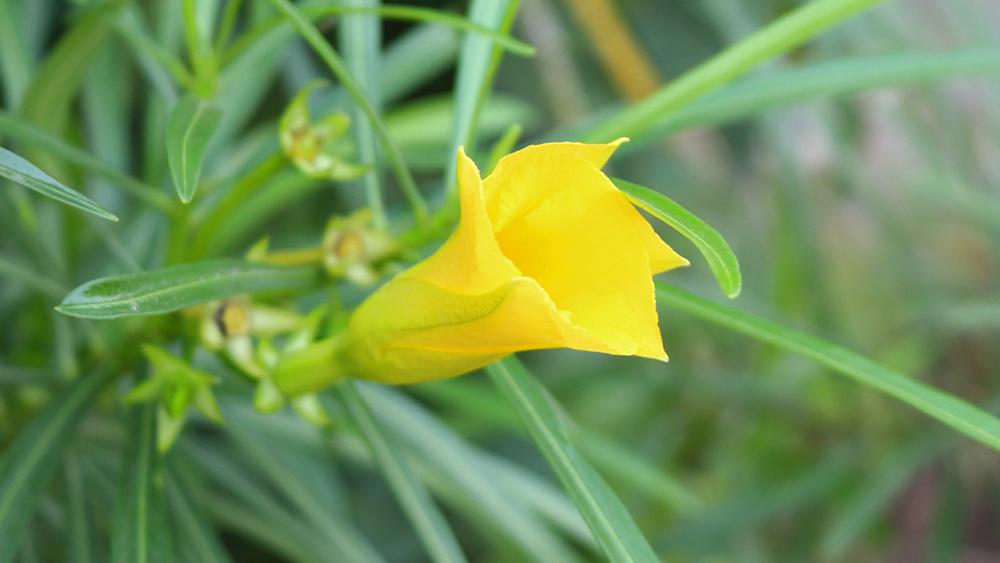
Belladonna (Atropa belladonna)
Belladonna, or deadly nightshade, is sometimes mistaken for blueberries. The whole plant is toxic, but its roots are the most dangerous. Belladonna contains a toxin called atropine which can increase your heart rate. Other side effects include dizziness and hallucinations.
Belladonna is bitter and a single leaf is toxic enough to potentially kill you.
Castor beans (Ricinus communis)
This plant produces castor oil, but castor beans are lethal. The beans have a high ricin concentration that can kill the average adult.
Castor beans lose their toxicity after they are heated to a certain temperature to produce castor oil. If you are exposed to castor beans before they are heated, you may suffer from permanent nerve damage.
Doll’s eye (Actaea pachypoda)
Doll's eye, also called white baneberry, contains different poisons that may cause immediate death once eaten. The whole plant is poisonous, and doll's eye berries are the most lethal since they have a high concentration of a cardiogenic toxin. The toxin will kill you by slowing the heart muscle until your heart stops beating.
Tell your children to avoid this plant, especially since most reported cases of poisoning involve kids who enjoyed the sweet taste of the poisonous berries.
Hemlock (Conium maculatum)
Hemlock is considered one of the most poisonous plants in North America because it has flowers that look very similar to Queen Anne’s lace flowers or parsnip. These similarities result in numerous poisoning incidents.
Hemlock has cicutoxin, a harmful chemical that can cause central nervous system damage. The symptoms of hemlock may include:
- Diarrhea
- Dizziness
- General weakness
- Seizures
- Stomach pain
- Tremors
- Vomiting
Sometimes, hemlock poisoning can result in death. If you believe you have accidentally consumed hemlock, watch out for symptoms like seizures because they may cause kidney failure, muscle breakdown, and swelling in the brain. These can cause death if the patient doesn't receive immediate medical attention.
Horsenettle (Solanum carolinense)
Horsenettle is often mistaken for heirloom tomatoes, especially since the former bears attractive fruits that look similar to the latter.
However, horsenettle contains a poisonous substance called alkaloid solanine. Once consumed, this substance may cause significant abdominal pain and circulatory and respiratory issues.
Oleander (Nerium oleander)
The whole oleander plant is poisonous if consumed or burned.
Oleander has a white, sticky sap that contains a toxin called cardenolide glycoside. This toxin is a type of steroid that can cause heart problems. Wash your hands immediately if you touch oleanders.
Pokeberries (Phytolacca americana)
Pokeberries are toxic, so avoid its fruit-bearing pinkish-purple stalks. (Related: Is it edible? 3 easy steps to determine if you’ve found something edible in the wild.)
A handful of pokeberries can kill a child, and eating a bit more can also kill an adult.
Other poisonous berry plants to avoid include:
- American bittersweet
- Cotoneaster
- Holly
- Juniper
- Yew
Rhododendron (Rhododendron ferrugineum)
This bush, which bears clusters of beautiful flowers, is one of the most poisonous plants known to man. The poison is concentrated in rhododendron leaves, but the entire plant is toxic to both humans and animals once consumed.
Avoid rhododendron nectar, which produces a toxic substance called grayanotoxin. This substance may cause side effects like diarrhea, nausea, overall weakness, and vomiting.
Rosary pea (Abrus precatorius)
Rosary pea, also called crab's eye or jequirity, is used in beading.
The plant contains abrin and this toxin is fatal to both humans and animals. Once ingested, abrin can cause liver failure, nausea, or even death.
Wild cherry (Prunus avium)
While wild cherries are edible, the plant's leaves and pits (seeds) have toxins. The leaves start producing fairly concentrated cyanide as they wilt and the pits can do the same when they are ground up.
Nonpoisonous edible plants
Now that you know about the poisonous plants listed above, here are some edible plants that you can read up on. Learn how to identify these plants properly so you can safely forage for them when SHTF.
- Chickweed (Stellaria media)
- Cress (Cardamine spp)
- Dandelion (Taraxacum officinale)
- Dead-nettle (Lamium purpureum)
- Henbit deadnettle (Lamium amplexicaule)
- Plantain (Plantago lanceolate)
- Sowthistle (Sonchus spp)
- Wild onion (Allium spp)
- Woodsorrel (Oxalis stricta)
Do your research on both edible and poisonous plants to avoid making a deadly mistake while foraging out in the wilds.
Sources include:
Please contact us for more information.






















